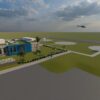Even today, aircraft wings are still assembled manually; but this process could soon be automated thanks to a novel snake-like robot capable of tightening bolts in even the most difficult-to-access cavities of the wing structure.
The volume of air traffic has soared in the past few decades, and aircraft manufacturer Airbus expects to see this figure triple by 2030. On a single day, more than 1,300 take-offs and landings are handled by the flight tower at Frankfurt’s international airport. This represents no less than 155,000 passengers who pass through this airport each day. To provide sufficient planes to cover this need for air transportation capacity, aircraft manufacturers will have to modernize their production processes.
Until now, aircraft assembly has involved a high proportion of manual processes, which limits production output. These processes must be automated to increase the rate of production. In certain cases this can be achieved easily, but wing assembly remains a major challenge. Why is this so? The main reason lies in the complicated internal structure of the wings, which consist of a series of hollow chambers. The only access to this space is through narrow hatches with a length of 45 centimeters and a width of 25 centimeters; this makes it extremely difficult for assembly workers to climb through these openings in order to fit the bolts that hold the parts together and seal the joints. This drilling and sealing operation has to be repeated around 3,000 times for each wingbox. This is time-consuming work that demands intensive physical effort that quickly leads to fatigue, not to mention the health risks resulting from the volatile organic compounds released by the sealing materials.
Read more at: http://phys.org/news/2014-04-automated-aircraft-wings.html#jCp







